
We Are More Than Our Numbers: Understanding and Responding to Adverse Childhood Experience Scores (ACEs) - Expanded Course
- A foundation grounded in trauma-informed principles and a team approach to care;
- An environment that is calm, safe, and empowering for patients;
- Education about the impacts of current and past trauma (and other adversities) on health; and
- Inquiry about and response to recent and past trauma that includes onsite or community-based resources and treatments.
- Establish the physical and emotional safety of patients and staff;
- Build trust between providers and patients;
- Recognize the signs and symptoms of trauma exposure on physical and mental health;
- Promote patient-centered, evidence-based care;
- Ensure provider and patient collaboration by bringing patients into the treatment process and discussing mutually agreed upon goals for treatment; and
- Provide care that is sensitive to the patient’s racial, ethnic, and cultural background, and gender identity
SUPPORT:
FEE:
UNLABELED USE DISCLOSURE:
PARTICIPATION AND CREDIT:
CULTURAL/LINGUISTIC COMPETENCY:
PRIVACY POLICY:
QUESTIONS:
COPYRIGHT:
Target Audience
This educational activity, designed for family physicians and their health care team members, stresses the relationship between ACE scores and ACE-Associated Health Conditions, including non-communicable diseases, and provides information on screening, treatment, management of ACEs and toxic stress, and trauma-informed care.
Learning Objectives
After reading this publication, learners should be able to:
- Define Adverse Childhood Experiences (ACEs), their prevalence, and their effects on health, including ACE-Associated Health Conditions (https://www.acesaware.org/treat/the-science-of-aces-toxic-stress/ ).5
- Explain the role of trauma and ACEs in patients’ risk for toxic stress and associated health conditions.
- Engage in conversations with their health care team members and their patients about ACE screening, the screening triad, and TIC.
Additional Information
| Attachment | Size |
|---|---|
| 782.54 KB |
PLANNERS, AUTHORS AND EDITORS
Conflict of Interest Statements:
The Committee on Continuing Professional Development and CME will be responsible for mitigating any relevant financial relationships disclosed by an individual who may have influence on content, who have served as faculty, or who may produce CME/CPD content for the CAFP. Mitigation may include learner notification, peer review of content before presentation, requirement of EB-CME, changing topics, or even dismissing a potential faculty member.
It is the policy of the CAFP to ensure independence, balance, objectivity, scientific rigor, and integrity in all continuing education activities. All individuals with potential to influence the content of this program have submitted Disclosure of Interest declarations that have been reviewed according to policy. Learner notification of declarations is below. All individuals with relevant financial relationships with ineligible companies have been contacted by CAFP staff or CCPD members, and issues of conflict have been discussed and mitigated.
Disclosure
NAME | AFFILIATION | ROLE | DISCLOSURE |
|---|---|---|---|
Brent Sugimoto, MD, MPH, FAAFP | Editor, California Family Physician magazine | Planner, Author and Editor | See above. Mitigated |
Shelly Rodrigues, CAE, MS, FACEHP | CAFP, Deputy Executive Vice President | Planner, Author and Editor | Nothing to Disclose |
Jessie Liu, MD | Contra Costa Regional Medical Center FMRP | Author | Nothing to Disclose |
Sway Wu, MD | John Muir FMRP | Author | Nothing to Disclose |
Adia Scrubb, MD, MPP | John Muir FMRP | Author | Nothing to Disclose |
Janani Sankara, MD, MPH | Scripps-Chula Vista FMRP | Author | Nothing to Disclose |
Serena Liu, MD | John Muir FMRP | Author | Nothing to Disclose |
Nadine Burke-Harris, MD, FAAP | State of California, Surgeon General | Author | Nothing to Disclose |
| Devika Bhushan, MD, FAAP | Chief Health Officer, Office of the Surgeon General | Reviewer | Nothing to Disclose |
| Tanya Schwartz, MSW, MPP | Aurrera Consulting | Reviewer | Nothing to Disclose |
| Brigid McGaw, MD, MPH, FACP | Aurrera Consulting | Reviewer | Nothing to Disclose |
| Matt Schueller | Office of the Surgeon General | Reviewer | Nothing to Disclose |
3.50 AAFP Prescribed
This Enduring Material activity, We Are More Than Our Numbers: Understanding and Responding to Adverse Childhood Experience Scores (ACEs) - Expanded Course, has been reviewed and is acceptable for up to 3.50 Prescribed credit(s) by the American Academy of Family Physicians. AAFP certification begins 05/21/2021. Term of approval is for one year from this date.
AAFP Prescribed credit is accepted by the American Medical Association as equivalent to AMA PRA Category 1 credit(s)™ toward the AMA Physician’s Recognition Award. When applying for the AMA PRA, Prescribed credit earned must be reported as Prescribed, not as Category 1.
Physicians should claim only the credit commensurate with the extent of their participation in the activity.
3.50 CA Board of Registered Nursing
The California Academy of Family Physicians is accredited by the Accreditation Council for Continuing Medical Education to sponsor continuing medical education for physicians. The California Academy of Family Physicians is an approved provider through the California Board of Registered Nursing, number #1809. This activity is approved for 3.50 nursing credits.
Clinicians should only claim credit commensurate with the extent of their participation in the activity.
3.50 AOA Category 2-A
The California Academy of Family Physicians is accredited by the Accreditation Council for Continuing Medical Education to sponsor continuing medical education for physicians. This activity is approved for 3.50 AOA Category 2-A credits.
Physicians should claim only the credit commensurate with the extent of their participation in the activity.
Available Credit
- 3.50 AAFP Prescribed
- 3.50 AOA Category 2-A
- 3.50 CA Board of Registered Nursing
Please click "take course" to register for this session. Questions? Please contact [email protected]

 Facebook
Facebook X
X LinkedIn
LinkedIn Forward
Forward